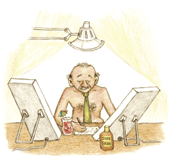

 |
 |
 Dr. Paul M. Caillier  |
Light can be effective treatment for Seasonal Affective DisorderWinter is here and unfortunately, so is Seasonal Affective Disorder (SAD). Seasonal Affective Disorder is a unique recurrent depression, which follows winter's timeline beginning around November and ending around March. Although its origins are not entirely clear, it is generally agreed that the decrease in daylight during the fall/winter season is a major cause. Researchers have speculated that it may be influenced by hormonal changes in the body in response to decreased daylight. Since the 1980's, researchers and practitioners have become aware of SAD, its effects and treatments. It's been found that 29% of the individuals attending clinics because of depression meet the criteria for SAD. It is found to affect woman more than men, returns year after year and occurs more frequently the further north on the globe one goes. A 1992 study found that 9% of the population in Fairbanks, Alaska met the diagnostic criteria for SAD, compared to only 5% of the population in Montgomery County, Maryland. Symptoms of Seasonal Affective Disorder include:
Seasonal Affective Disorder is treated using the traditional treatments for depression. Psychotherapy and anti-depressant medication are effective, but can be much more effective when combined with phototherapy. Phototherapy involves exposing the patient to a light that is sufficiently intense for 30 to 120 minutes per day. The types of wavelengths that produce the anti-depressant effects have yet to be clarified. The majority of studies recommend full spectrum fluorescent tubes, which are similar to ordinary fluorescent but with more blue and near ultraviolet, and less yellow light. This light can be delivered to the eye either through light boxes containing fluorescent tubes or by eye visors, which are placed on the patient's head and designed to shine the light into their eyes. The light visors have the advantage of being portable. The patient looks into the light, which can be relatively dim (300 lux) or bright (10,000 lux) with a normal blinking response. In general, it has been found that the more intensive light works more quickly than the dimmer lights and thus requires sitting in front of the lights only a few minutes per day. Research has been done on when is the best time of day for administration of the light. It appears to work better if administered in the morning. Another option, known as dawn simulation, allows for light to gradually increase in brightness in the morning while the patient is asleep until they come to an awake state. Are there side effects?Research into light therapy reports mild side effects including headaches, eyestrain and "feeling wired". It has also been found that if an individual is using light therapy and stops the treatment for a few days, they quickly relapse back into their symptoms. The intensities of the light used in light therapy are not considered harmful to the human retina based on short-term studies, but the long term effects of exposure are not known. Some have suggested that light therapy has the potential risk of aggravating unrecognized retinal problems and have suggested that an ophthalmologist screening is advisable prior to the beginning of light therapy. Research has also been done on the effect of the patient's expectations. In many psychological and medical treatments, if the patient believes they are gaining some benefit from the treatment, this increases the chances that they will benefit. The majority of studies looking for this effect with phototherapy have suggested that the effects of the treatment are too substantial to be caused solely by the patient'vs expectation. If you, or someone you know, suffer from the symptoms above, contact your mental health professional or physician to get more information on SAD and its treatment. It is important to get a clear diagnosis as to the origins of your depressive symptoms before appropriate treatment can be designed and implemented. For more information on Seasonal Affective Disorder, or to schedule an appointment, contact Dr. Caillier at Caillier Clinic, Ltd. Eau Claire at 715.836.0064 or 800.880.3303 |
|